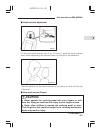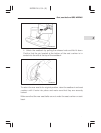
IMPREZA U.S.A. (E)
2-10
3-point type seat belts
(Combination lap/shoulder belts)
WARNING
D Never use a belt that is twisted or reversed. In an accident, this
can increase the risk or severity of injury.
D Never place the shoulder belt under the arm or behind the
back. If an accident occurs, this can increase the risk or severity
of injury.
D Keep the lap belt as low as possible on your hips. In a colli-
sion, this spreads the force of the lap belt over stronger hip
bones instead of across the weaker abdomen.
D Seat belts provide maximum restraint when the occupant sits
well back and upright in the seat. To reduce the risk of sliding un-
der the seat belt in a collision, the front seatbacks should be al-
ways used in the upright position while the vehicle is running. If
the front seatbacks are not used in the upright position in a colli-
sion, the risk of sliding under the lap belt and sliding up of the lap
belt over the abdomen will increase, and both can result in seri-
ous internal injury or death.
D Do not put cushions or any other materials between occupants
and seatbacks or seat cushions. If you do so, the risk of sliding
under the lap belt and of the lap belt sliding up over the abdomen
will increase, and both can result in serious internal injury or
death.
D Put children aged 12 and under in the rear seat properly re-
strained at all times. The SRS AIRBAG deploys with considerable
speed and force and can injure or even kill children, especially if
they are 12 years of age and under and are not restrained or im-
properly restrained. Because children are lighter and weaker than
adults, their risk of being injured from deployment is greater. For
that reason, we strongly recommend that ALL children (including
those in child seats and those that have outgrown child restraint
devices) sit in the REAR seat properly restrained at all times in a
child restraint device or in a seat belt, whichever is appropriate


















